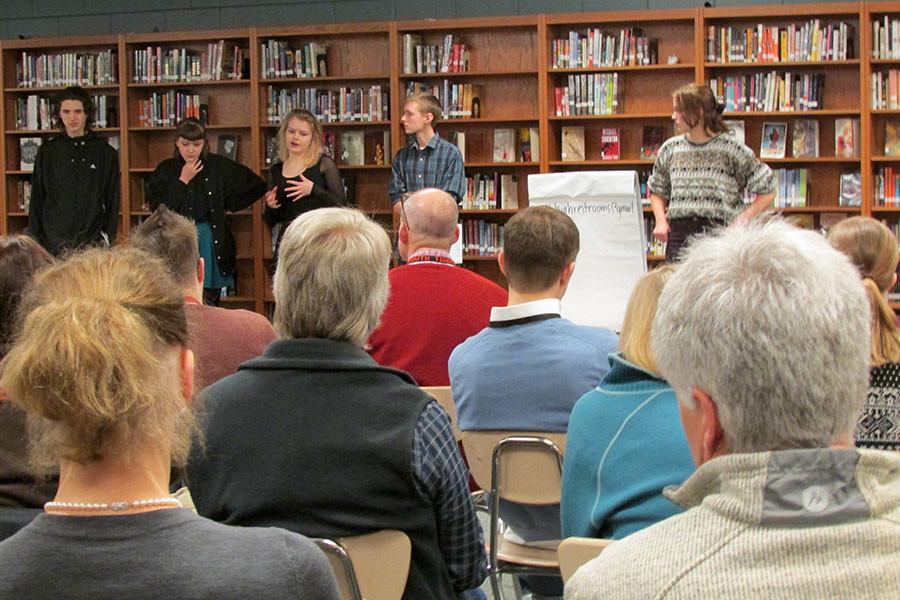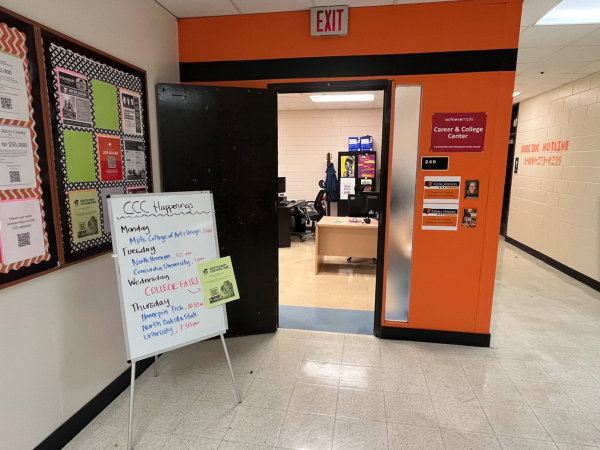Gender neutral bathroom will open at South in April
Juniors Sidonia Zinky, Chris Mann, Aidan Denison, Rex Otto and Soline Van de Moortele present their plans for gender neutral bathrooms to the South staff meeting.
March 6, 2015
Unbeknownst to many South students, there is one gender neutral restroom at South right now. It is located in the nurses’ office. Because of its location, the one gender neutral bathroom is not as effective as it would be if there was one on the second floor by the media center.
“I believe we need to have gender neutral bathrooms for those of us who are not only trans, but nonbinary or gender fluid people, like myself,” explained senior Lydia Chapman. Chapman doesn’t identify with a specific gender and is “casual” about pronouns. She continued, “This [bathroom] is not a place to joke around or anything . . . It’s an actual place that will make us feel comfortable. If we want South to be a totally welcoming place, we need this.”
The Gender Equity Club recognized the situation and brought it to the attention of Principal Ray Aponte. In a meeting with Aponte, juniors Chris Mann and Sidonia Zinky represented the Gender Equity Club.
“This project started as a . . . petition to the Minneapolis School Board to incorporate gender-neutral restrooms in all Minneapolis Public Schools,” Zinky explained. Zinky continued, “While I was gathering student support signatures, Chris offered to help with the project. Around this time, we figured out focusing on South would have a higher chance of success. We began writing and meeting with Aponte and vocalising our efforts in the school.”
Mann and Zinky “joined forces” in November 2014 through the Gender Equity club. “It took a long while. A lot of the time was spent waiting for responses from various people, but things didn’t really start moving until we asked people to get involved. It only took two or three weeks of widespread student involvement to see some concrete change. The power that we students have when we advocate for ourselves is incredible,” said Mann.
Aponte described that he wasn’t the only person who needed to be consulted in order to establish another gender neutral bathroom.
He explained, “I started writing [the district] to find out if there’s anything I need to worry about in terms of school law. He was researching that for me, and then I did my own research to find who was out there having gender neutral bathroom discussion . . . a lot of universities have started having that conversation in the last six months to a year.”
Aponte juggled the positive and negative responses to the introduction of gender neutral restrooms. He brought in someone to assist their hunt for a location for the new bathroom. Mann, Aponte and a district official were able to dicuss where the best location would be.
“I understand the need for it, but somebody’s habits are going to have to change. I want it to be in a location where it’s not hidden . . . because I’d like for it to be a bit more mainstream,” Aponte explained.
Chapman’s ideal gender neutral bathroom would be one that was “most convenient” and “would be just a bathroom with stalls.” Chapman believes that there is “nothing wrong with that, or ‘risque’. [She wants] people to know that there are many genders beyond the binary ones.”
“Our . . . bathroom system . . . conveyed a message that nonbinary genders were abnormal or wrong. We dismantled that. This message was so constant in our community that it could be seen in the physical layout of the building. By changing the messages in our environment, we’re changing how people interact,” Mann described of his hopes for the final product.
After the meeting, Aponte, Zinky, and Mann came up with a plan: “the second floor male staff bathroom was to become a student gender neutral bathroom [on] March 2nd,” said Mann. “Leading up to that, we were going to launch a media campaign to promote awareness and create a more accepting environment.”
However, because the male staff on the second floor were going to be displaced, there were many objections to the new restroom plan. Mann and Zinky, accompanied by the Gender Equity Collective and a handful of staff, finalized a proposal the day after speaking to the staff.
On April 6th, 2015, the current female restroom on the second floor, near the math center, will be converted to a gender neutral restroom. The restroom will be “open to any student, regardless of gender, who wishes to use it” as stated by the proposal written by the South High Gender Equity group.
Mann proudly wrote in an email regarding a Gender Equity Collective meeting to discuss the bathroom: “in attendance was the normal Gender Equality Collective, several interested staff . . . We also met with Aponte and the LGBT district representative, Jason Buckli. We all left . . . feeling as if some real change was falling in place and we all know exactly what has to be done to see this movement through.”
“I thank this group for pushing me to expand my mindset around gender equity, and how society has instilled a certain thought process on gender neutral people. These issues are what attracted me to South and I hope to continue to lead our Tiger community in a respectful and inclusive way,” concluded Aponte.
In the end, Zinky said, “One of my biggest goals with this is to normalize nonbinary genders. I want nonbinary genders to stop being some sort of hazy, liberal political discussion point, and instead become unquestioned genders.”













stan • Mar 18, 2015 at 9:42 pm
I can’t wait to check my privilege in here!